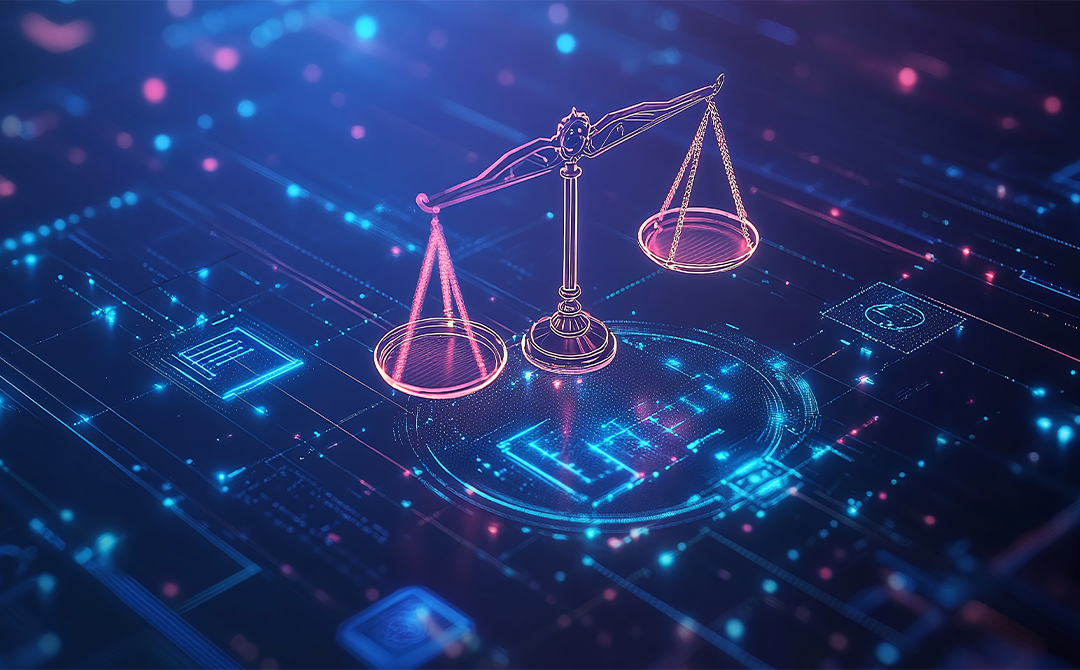
AI continues to revolutionize the business world, offering data-driven decision-making, scalable automation, and competitive advantage. However, even the most advanced AI systems can misinterpret subtle context or ethical considerations when operating alone. According to a Gartner report, in 2025, only 24 percent of businesses have successfully scaled these solutions to full operational maturity, even though 70 percent of enterprises are actively researching AI. (Source: Gartner)
Hybrid AI overcomes this gap by weaving human expertise into machine learning workflows, embedding feedback loops, and continuous model retraining to refine algorithmic outputs and ensure accountability.
The move toward hybrid solutions, including human feedback loops, continuous model retraining, and an explainable AI framework, becomes vital as companies navigate increasingly complex AI environments. This blog will teach you how companies in retail, healthcare, and manufacturing utilize hybrid AI to deliver scalable, responsible, and impactful AI-driven results.
Hybrid AI in Action: Addressing Real-World Limitations of Traditional AI
Enterprises continue to pour resources into fully automated AI and generative models, yet these systems frequently falter when confronted with edge cases or shifts in the external environment. Unsupervised domain-specific logic can lead to hallucinations in generative AI, resulting in costly errors or compliance breaches. Hybrid AI overcomes this by weaving human expertise directly into the model lifecycle, blending contextual judgment with machine efficiency, rather than correcting mistakes after the fact.
Consider retail pricing engines: Pure AI models can analyze historical sales data and recommend markdowns, but they often fail during supply-chain disruptions or sudden demand shifts. By incorporating merchandisers’ overrides as structured feedback, a hybrid AI system not only refines its own thresholds but also learns to anticipate anomalies, improving both prediction accuracy and operational resilience.
AI-driven maintenance alerts based on sensor readings in manufacturing can overwhelm engineers with false positives. Hybrid AI routes these alerts through floor-level validation: engineers confirm genuine faults and dismiss noise, feeding this human judgment back into the model. The result is fewer unnecessary shutdowns, dynamically calibrated thresholds, and an explainable audit trail that meets regulatory requirements.
By capturing expert inputs via annotation, manual overrides, or escalation workflows, hybrid AI continuously adapts to real-world complexity. Organizations gain faster insights, reduced operational risk, and a clear line of accountability, making AI agile and enterprise-ready.
How Hybrid AI Enhances Human Decision-Making in High-Stakes Use Cases
Hybrid AI layers deterministic rules and expert oversight on top of probabilistic models, addressing the limitation of traditional AI in context-sensitive scenarios while ensuring transparency and reliability.
Consider a major online retailer that uses pure ML techniques to forecast demand for products. Although projections show better general accuracy, seasonal fluctuations, such as a sharp increase in hand sanitizer sales early in 2020, were routinely misinterpreted. Supply chain analysts identified these anomalies and adjusted the model's parameters before complete automation by incorporating a human-in-the-loop assessment. During unpredictable times, it resulted in a 30 percent reduction in inventory waste and a model that "learns" from both data and expert opinion. (Source: McKinsey)
Similarly, a financial services provider enhanced its alert system for spotting fraudulent behavior by including compliance officials. Human reviewers quickly reviewed alarms and returned validated cases to the model, rather than hundreds of false positives swamping the system per hour. This prevented the system from being overwhelmed over time; the hybrid technique was able to reduce the research overhead by half and increase the model's precision, all without sacrificing the speed that automated technologies could provide.
These use cases demonstrate how hybrid AI fills the gaps in conventional wisdom. Enterprises can address unanticipated difficulties and close gaps that pure AI cannot by arranging flawless cooperation between humans and technology.
Core Building Blocks of Enterprise-Grade Hybrid AI Systems
Below are the foundational components that enable enterprises to deploy robust, scalable Hybrid AI solutions:
Unified Data Platform
A centralized data layer—whether on-premises, in the cloud, or a hybrid environment—ensures every AI component and human reviewer works from the same, high-quality dataset. This unified approach eliminates silos, enforces consistent governance policies, and accelerates collaboration between data scientists and domain experts.
Machine Learning and Generative AI Engines
By coupling structured ML pipelines for predictive tasks with generative AI capabilities for unstructured insights, organizations can seamlessly transition from forecasting trends to creating personalized content. This dual-engine strategy expands use cases from demand planning to dynamic customer engagement, while maintaining model integrity and consistency.
Human-in-the-Loop Interfaces
Review interfaces included in hybrid AI systems let experts validate or correct model outputs. This preserves context and accountability through an organized feedback loop, improving accuracy and highlighting any biases or mistakes that may have occurred before deployment, thereby supporting responsible AI methods.
Continuous Feedback Loops and Model Retraining
Structured human reviews feed corrections back into your ML lifecycle, triggering automated retraining and versioning. Leveraging MLOps services for pipeline orchestration, monitoring, and scheduled updates ensures your models remain accurate and aligned with evolving business conditions.
Explainability and Governance Frameworks
Companies should demonstrate transparency when making decisions based on the impact of AI. Explainable AI libraries and governance policies, which encompass audit trails, access restrictions, and additional compliance checks, ensure the compliance of hybrid AI systems with internal standards and regulatory requirements.
Deployment and Monitoring Infrastructure
Robust MLOps services encompass the entire end-to-end lifecycle, from model packaging and containerized deployment to drift detection and performance monitoring in production. Coupling these pipelines with AI Consulting support helps organizations plan scalable rollouts.
Security and Compliance Layers
Data encryption, role-based access, and anomaly detection guard sensitive inputs, while compliance frameworks (e.g., SOC 2, GDPR) ensure that Hybrid AI solutions meet enterprise risk standards. For teams new to AI, starting with a primer like AI 101 can help clarify essential governance concepts.
These building blocks work in concert to deliver Hybrid AI solutions that are not only powerful and flexible but also secure, explainable, and fully aligned with enterprise objectives.
Real-World Applications of Hybrid AI in Retail, Healthcare, and Manufacturing
Hybrid AI is not merely a theoretical framework; it is driving measurable improvements where data complexity and human expertise intersect. Below, we explore three industry scenarios in which this collaborative approach delivers a clear business impact.
Retail: Personalized Demand Forecasting
By combining machine-driven demand predictions with merchant insights, retailers can adjust their strategies to account for local trends and sudden shifts in customer behavior. In pilot programs, this Hybrid AI approach resulted in a 20 percent reduction in stockouts, ensuring that products remain available when and where customers need them. (Source: Medium)
Healthcare: Diagnostic Accuracy Enhancement
Integrating clinician review into AI-powered diagnostic workflows helps validate ambiguous cases and reduce algorithmic errors. Clinical studies have reported a decrease in false positives for early-stage disease detection when human experts review AI suggestions before making final decisions. (Source: BMCMededuc)
Manufacturing: Predictive Maintenance
Sensor-driven alerts identify potential equipment faults, but it is the engineer’s contextual judgment that prevents unnecessary downtime. Organizations employing Hybrid AI for maintenance planning have seen 70 percent fewer unplanned breakdowns by routing machine alerts through expert validation. (Source: Fortna)
Hybrid AI transforms isolated algorithms into adaptive, context-aware systems, resulting in tangible reductions in stockouts, false positives, and downtime. By embedding human oversight into automated workflows, organizations boost both performance and trust in their AI deployments.
Operationalizing Hybrid AI: From Machine Learning Outputs to Human-in-the-Loop Feedback
As organizations move beyond pilot projects and embed AI into core operations, the real test becomes ensuring those models continually improve with real-world input. Here's how enterprises transform standalone ML predictions into hybrid workflows that learn and adapt over time.
Operationalizing at its most basic form is based on a disciplined feedback loop. Machine-generated insights flow through review interfaces in this loop, where experts assess or fix the outcomes. Human annotations returned to the training pipeline initiate the processes for automatic model retraining, which, over time, improves performance through their feedback. Through MLOps technology, companies can automate data versioning, track model drift, and create retraining plans to build systems that are capable of situational adaptation.
Through the formalization of review checkpoints and the merging of input at scale, companies ensure that hybrid AI accelerates the decision-making process while preserving responsibility and openness throughout the system's entire lifecycle.
Hybrid AI vs Fully Automated AI: When to Blend, When to Automate
As enterprises scale their AI initiatives, deciding whether a task requires human collaboration or pure automation is crucial. Evaluating factors like complexity, compliance, and speed helps determine the optimal mix. Below is a concise comparison of key criteria for Hybrid AI versus fully automated AI:
|
Criterion |
Hybrid AI |
Fully Automated AI |
|
Decision Complexity |
High – requires contextual judgment |
Low to Medium – rule-based or clear patterns |
|
Explainability Needs |
Critical – human review ensures transparency |
Limited – depends on black-box models |
|
Regulatory Constraints |
High – mandates audit trails and oversight |
Moderate – compliance baked into code |
|
Speed vs. Accuracy |
Balanced – human checks add time for higher precision |
Fast – minimal latency but potential errors |
|
Feedback Loop |
Continuous – expert corrections feed retraining |
Sporadic – retraining on aggregate data |
Hybrid AI is ideal for scenarios that demand nuanced judgment, rigorous oversight, or strict regulatory compliance, while fully automated AI is best suited for large-scale, repetitive processes with clear rules. To strike the right balance and scale effectively, many organizations turn to AI Consulting to customize hybrid and automated solutions to their unique operational and governance needs.
How to Implement Hybrid AI in Your Organization: A Step-by-Step Guide
Getting started with Hybrid AI requires precise planning, the right infrastructure, and cross-functional collaboration. Below are actionable steps to guide your implementation journey:
Step 1: Define Use Cases and Success Metrics
Identify high-impact scenarios such as fraud detection, personalized marketing, or predictive maintenance, where human judgment complements machine insights. Establish KPIs like accuracy improvements, turnaround time reductions, or cost savings to measure success.
Step 2: Assemble a Cross-Functional Team
Assemble a specialized team comprising information technology engineers, subject experts, data scientists, and compliance officials. This team will be responsible for supervising the design of human-in-the-loop interfaces, model development, and governance rules.
Step 3: Establish a Unified Data Platform
Consolidate data sources, such as customer relationship management (CRM), enterprise resource planning (ERP), and Internet of Things (IoT) sensors, into a uniform repository that features thorough data quality checks. A single source of truth is necessary to ensure that both expert reviews and machine learning are based on reliable inputs.
Step 4: Develop and Integrate Machine Learning Pipelines
Build ML workflows for initial model training using historical data. Incorporate MLOps services to automate data versioning, model packaging, and deployment.
Step 5: Design Human-in-the-Loop Workflows
Create intuitive review interfaces that enable experts to validate or correct AI outputs. Embed structured feedback loops that capture human annotations and route them back into the training pipeline.
Step 6: Implement Continuous Model Retraining
Automated retraining initiatives can be established in response to drift warnings or newly labeled data. This helps models develop, depending on both fresh data and human expert input, thereby maintaining their accuracy and relevance over the long run.
Step 7: Embed Explainability and Governance Controls
Integrate explainable AI models and audit capabilities to surface decision rationales. Specify responsibilities, access limits, and compliance checklists in accordance with the policies governing the use of AI in your firm.
Step 8: Pilot, Evaluate, and Scale
Run under controlled pilot projects to validate performance against important performance criteria. Following the first goals is essential to gather feedback from stakeholders, streamline processes, and ultimately expand to other departments or geographical areas.
Armed with this implementation roadmap, your organization can seamlessly integrate human expertise and machine intelligence to build robust Hybrid AI workflows. The result is a system that continuously learns from expert feedback, adapts to evolving data, and delivers reliable, scalable insights that drive tangible business value.
Challenges and Solutions in Hybrid AI Implementation
Even the most robust Hybrid AI initiatives can stumble without careful planning. Below are four common challenges and proven practices to address them:
Data Quality and Integration
Challenge: Inconsistent or siloed data sources can lead to mismatches between model outputs and expert reviews.
Solution:
- Establish a unified data platform with clear standards and validation rules.
- Automate data ingestion and profiling to catch errors before they enter ML pipelines or review workflows.
- Synchronize on-premises and cloud data sources so models and human reviewers always work from the same information.
Change Management and Skills Alignment
Challenge: Hybrid AI necessitates collaboration among technical teams, domain experts, and business stakeholders, which can lead to resistance or skill gaps.
Solution:
- Provide targeted training that blends AI fundamentals for domain experts and business context for data teams.
- Appoint “AI champions” in each department to bridge communication between technical and non-technical groups.
- Highlight early successes through small-scale pilots to build confidence and secure ongoing executive support.
Model Drift and Continuous Maintenance
Challenge: Over time, evolving business conditions can render models less accurate if not regularly updated.
Solution:
- Implement automated monitoring to detect performance degradation and trigger retraining.
- Use MLOps tools to version data, models, and code for reproducible rollbacks when needed.
- Schedule periodic human-in-the-loop reviews to compare model predictions against actual outcomes and recalibrate as necessary.
Governance, Explainability, and Compliance
Challenge: Regulatory and audit requirements demand a clear rationale for AI-driven decisions and traceability of human interventions.
Solution
- Integrate explainable AI techniques to produce human-readable decision justifications.
- Maintain immutable audit logs that capture both model outputs and expert corrections.
- Enforce role-based access controls so only authorized users can adjust models or override recommendations.
Effective management of data, people, models, and governance transforms Hybrid AI from a theoretical concept into a reliable enterprise capability. Embracing these best practices sets the stage for resilient, scalable, and compliant hybrid AI deployments.
Future of Enterprise Intelligence: Hybrid AI and GenAI Working Together
Regarding AI for companies, the junction of generative AI with hybrid AI capabilities marks the next horizon. When companies incorporate large language models (LLMs) into human-in-loop systems, they not only generate insights but also improve and contextualize those findings immediately. Generative AI allows finance teams, for example, to create profit summaries. Subsequently, subject-matter specialists could edit them for nuance, tone, and regulatory compliance, thereby accelerating the report-generation process.
As AI continues to develop, this symbiosis will uncover new efficiencies. While explainable AI techniques will guarantee that generative outputs continue to maintain transparency and confidence, constant model retraining with human feedback will improve the accuracy of LLM. Companies that invest in this hybrid-generative AI approach can establish themselves as leaders of ethical innovation in AI by attaining faster adoption of AI and managing governance challenges with built-in feedback loops.
Conclusion: Why Hybrid AI is Key to Scalable, Responsible AI in the Enterprise
Hybrid AI strikes a strategic balance between automation and human expertise by addressing the primary weaknesses that fully automated solutions cannot overcome. Structured human input, constant model retraining, and robust governance systems enable companies to achieve higher levels of decision accuracy, increased confidence, and demonstrable commercial impact. Integrating generative AI technologies into hybrid architectures will be essential for companies that wish to scale responsibly and maintain their competitive advantage in an environment increasingly driven by AI as its prevalence rises.
Work with our Tredence AI Consulting professionals to create customized hybrid AI solutions that ensure compliance, inspire creativity, and deliver tangible outcomes. Get in touch now to discover how we can help you achieve responsible, scalable AI excellence.
FAQs
1. What is Hybrid AI, and how does it work in enterprise environments?
Hybrid AI combines human knowledge with machine learning techniques inside the framework of ordered feedback loops. AI models anticipate, and human reviewers examine or adjust the outputs to ensure that solutions remain accurate, explainable, and in line with corporate objectives. The model retraining process then consumes this feedback back into itself.
2. How does Hybrid AI improve decision-making compared to traditional ML?
Traditional machine learning, meanwhile, may lack context, which may lead to mistakes when handling complex problems. Especially in controlled fields like healthcare and finance, embedding human judgment into hybrid AI enables the enhancement of model outputs with domain knowledge, the reduction of false positives, and the improvement of explainability, all of which are particularly crucial.
3. Which industries benefit most from Hybrid AI applications?
For sectors like retail (demand forecasting), healthcare (diagnostics), and manufacturing (predictive maintenance), which make decisions with great stakes, hybrid AI can have quite positive results. These industries are ideal candidates for the application of hybrid techniques, as they combine significant volumes of data with the subtle insights of people.
4. How can I implement Hybrid AI in my organization?
Form a cross-functional team, start with defining use cases and KPIs, then progressively build a single data platform. Create machine learning pipelines that are linked with human-in-the-loop interfaces, run continuous retraining using MLOps tools, and incorporate governance controls. Create a pilot, assess it, and then expand it depending on its performance relative to the specified KPIs.

AUTHOR - FOLLOW
Editorial Team
Tredence
Next Topic
Unlocking Data Intelligence with Databricks: Cloud Use Cases for Azure, AWS, and GCP
Next Topic




